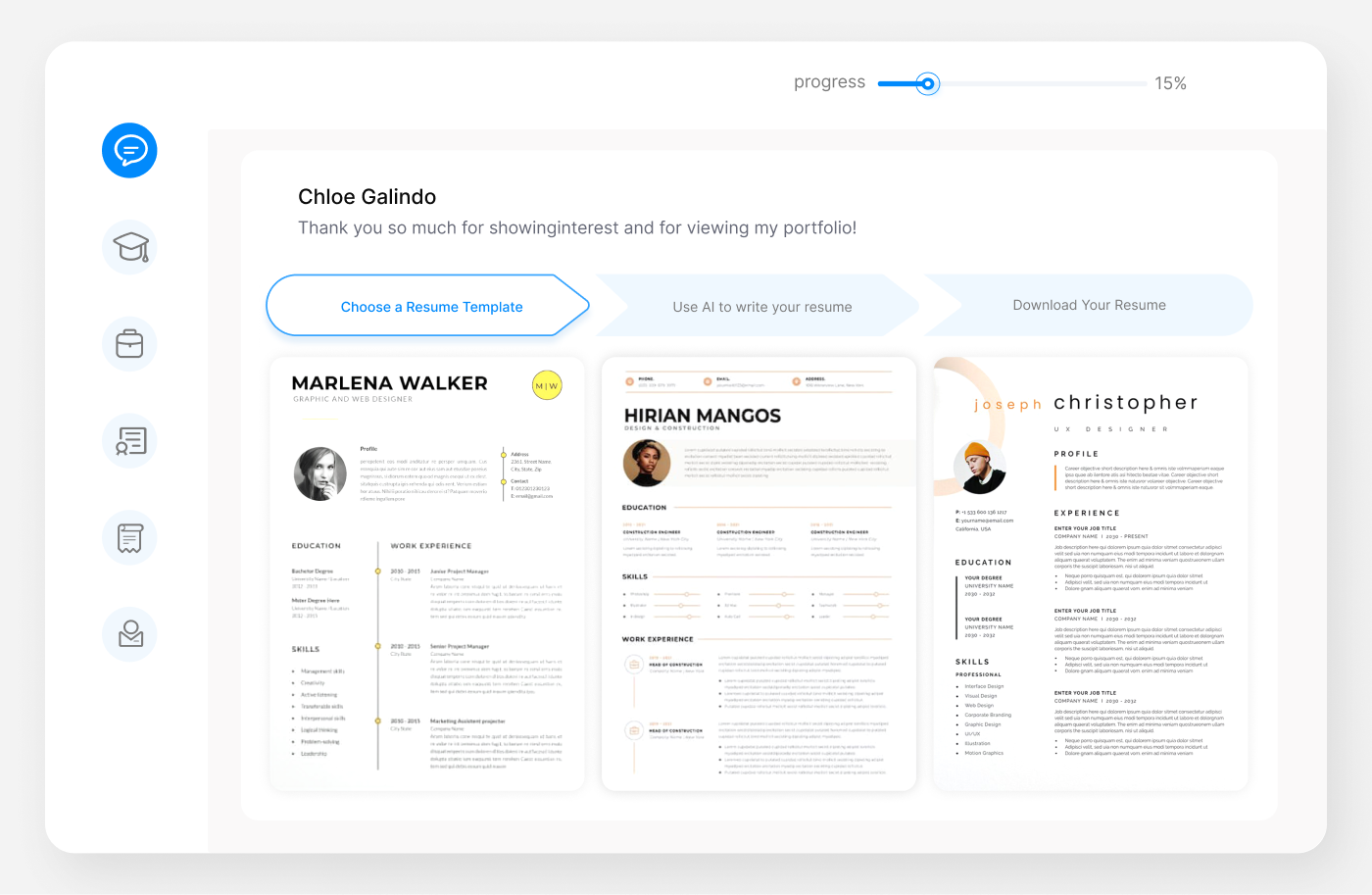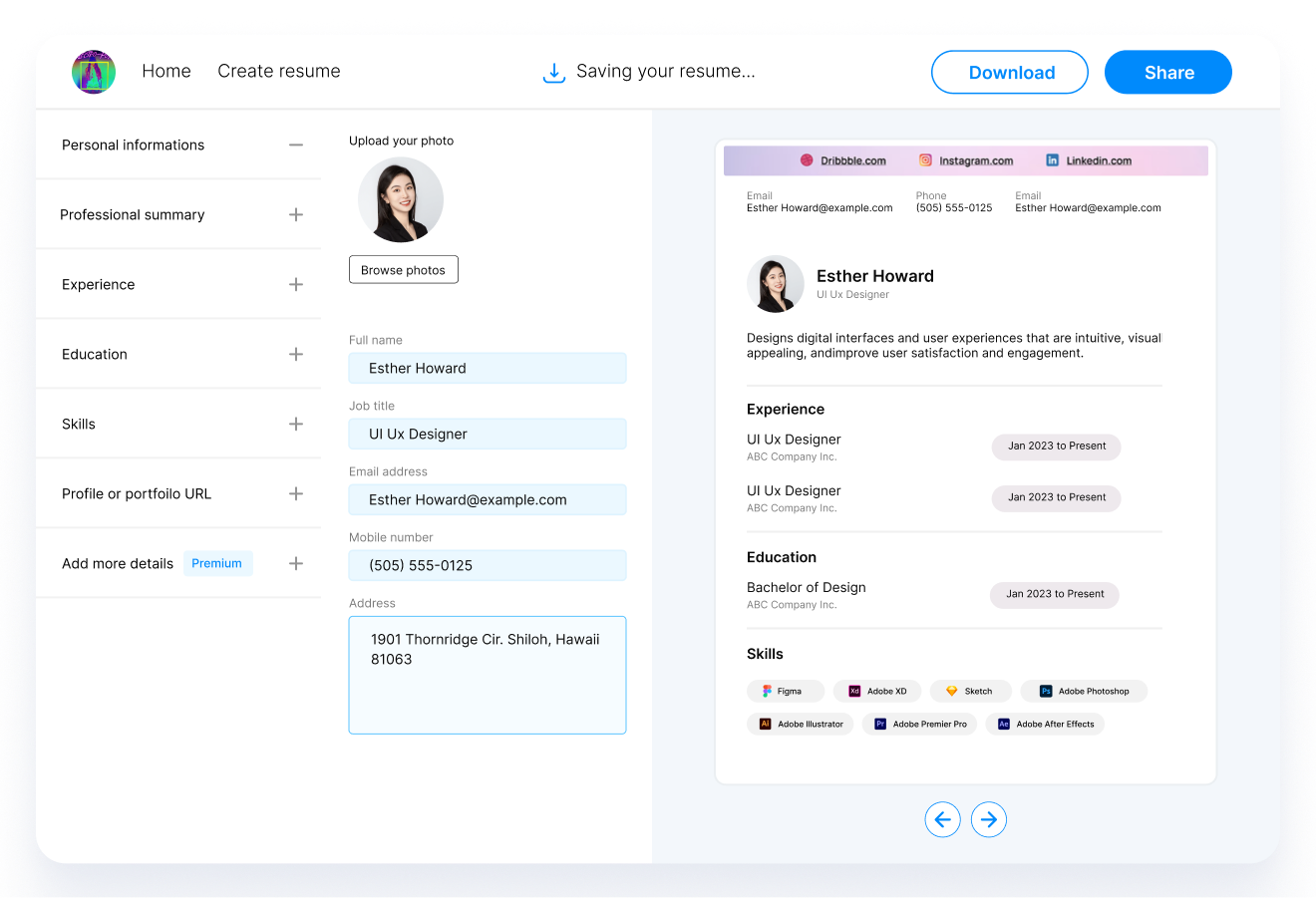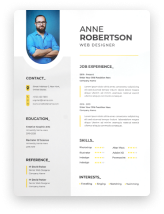In the world of law enforcement and emergency services, having a standout resume is crucial. Firefighting is not just a job; it's a call to serve, requiring a unique blend of bravery, physical prowess, and compassion. In this guide, we dive into the intricacies of crafting a firefighter resume that captures your dedication and skill set. Whether you're a seasoned veteran or aspiring to join the fire service, this article will provide you with the tools and knowledge to create a resume that resonates with hiring managers in this noble profession.

Firefighter Resume Example: A Real-World Blueprint
Ryan Mitchell
Firefighter | EMT Certified
Email: ryan.mitchell@example.com
Phone: (555) 123-4567
Address: 789 Firefighter Lane, Springfield, IL
Professional Summary:
Dedicated firefighter with over 5 years of experience in emergency response and fire suppression. Proven track record in high-pressure situations, demonstrating exceptional problem-solving skills, physical fitness, and a commitment to public safety. EMT certified with a strong background in providing first aid and emergency medical assistance.
Work Experience:
Springfield Fire Department
Springfield, IL
Firefighter/EMT
June 2018 - Present
-
Responded to over 300 emergency calls, effectively performing fire suppression and rescue operations.
-
Conducted fire safety inspections and public education programs, contributing to a 20% reduction in fire incidents in the community.
-
Collaborated with a team of 10 firefighters, coordinating efforts in emergency situations to ensure public safety.
-
Maintained and operated fire apparatus and equipment, ensuring readiness for immediate response.
Volunteer Experience:
Habitat for Humanity
Springfield, IL
Volunteer Fire Safety Officer
January 2017 - May 2018
-
Organized fire safety workshops for local communities, educating over 500 residents on fire prevention techniques.
-
Assisted in the installation of smoke detectors in low-income neighborhoods, enhancing community safety.
Education:
Illinois Fire Service Institute
Firefighter Certification 2016
Springfield Community College
Springfield, IL
Associate of Science in Emergency Medical Services2
014 - 2016
Skills:
-
Fire Suppression Techniques
-
Emergency Medical Response (EMT Certified)
-
Hazardous Material Handling
-
Public Safety and Education
-
Teamwork and Communication
Certifications:
-
Firefighter I & II Certification
-
EMT-Basic Certification
-
Hazardous Materials Operations
Structuring a Firefighter Resume: Clear Formatting for Maximum Impact
When crafting a firefighter resume, the structure and format are as critical as the content. This section provides detailed guidance on organizing your resume to highlight your strengths effectively. Let's dive into the key components and the best ways to present them for a firefighter role.
The Importance of a Well-Organized Resume A well-structured resume not only looks professional but also makes it easier for hiring managers to identify your key qualifications. In the emergency services sector, where quick decision-making and clarity are valued, a well-organized resume reflects these qualities.
Choosing the Right Resume Format
There are several resume formats to consider, each serving a different purpose:
-
Chronological Format: Ideal for those with a solid and continuous work history in firefighting or related fields. It lists work experience in reverse chronological order.
-
Functional Format: Suitable for individuals with gaps in their employment or those transitioning from a different career. It focuses more on skills and less on chronological work history.
-
Combination Format: A hybrid of chronological and functional formats. It's useful for highlighting specific skills while providing a detailed work history.
Key Sections of a Firefighter Resume
-
Header: Includes your name, contact information, and often a professional title (e.g., Certified Firefighter).
-
Professional Summary or Objective: A brief statement summarizing your experience, skills, and what you bring to the role. An objective is more suited for those new to the field or changing careers.
-
Work Experience: List your relevant past positions, focusing on duties and achievements that align with firefighting roles. Quantify achievements where possible.
-
Education: Include relevant educational qualifications, such as degrees in fire science or EMT certifications.
-
Skills: Highlight specific skills crucial for firefighting, such as emergency response, teamwork, and physical fitness.
-
Certifications: Any additional certifications like EMT or HazMat should be listed here.
Formatting Tips
-
Use a clear, professional font like Arial or Calibri.
-
Keep your resume to one or two pages.
-
Use bullet points for readability.
-
Be consistent with your formatting choices throughout the document.
Resume Summary or Objective: Crafting a Powerful Introduction for Firefighters
The Power of a Well-Crafted Resume Summary or Objective
For firefighters, the resume summary or objective is more than just an introduction. It's your first opportunity to make an impression and highlight your dedication, experience, and the unique qualities you bring to the role. This section is critical in setting the tone for your entire resume.
Crafting a Compelling Resume Summary
A resume summary should succinctly encapsulate your years of experience, key skills, and significant achievements. It's ideal for experienced firefighters who can showcase their career highlights.
Example of an Effective Firefighter Resume Summary:
"Seasoned Firefighter with over 10 years of experience in urban and forest fire suppression, emergency medical response, and public safety education. Adept at leading teams in high-pressure environments and known for exceptional problem-solving skills and physical endurance. Recognized for bravery during the Springfield Forest Fire of 2019 and instrumental in developing community fire safety programs."
Writing an Impactful Resume Objective
The resume objective is suitable for those new to the firefighting field or transitioning from a different career. It should focus on your career goals, relevant skills, and how you plan to contribute to the department.
Example of a Strong Firefighter Resume Objective:
"Motivated and physically fit professional with a background in emergency response and volunteer firefighting. Seeking to leverage my EMT certification and passion for community service to contribute effectively as a firefighter with the Springfield Fire Department. Committed to maintaining high safety standards and eager to further develop firefighting skills."
Tailoring Your Summary or Objective
Remember to tailor your summary or objective to the specific firefighter role you're applying for. Use keywords from the job description and focus on what makes you a unique candidate for that position.
Firefighter Resume: Showcasing Your Work Experience
Highlighting Your Professional Journey in Firefighting
The Work Experience section is a pivotal part of your firefighter resume. It's where you demonstrate your practical experience in the field, showcasing specific roles, responsibilities, and accomplishments. This section should clearly articulate how your past experiences make you an ideal candidate for the firefighter position you're applying for.
Structuring Your Work Experience
-
Reverse Chronological Order: Start with your most recent job and work backward. This format is straightforward and preferred by most hiring managers.
-
Job Title and Dates: Clearly state your job title and the duration of each role. Include the name and location of the fire department or organization.
-
Responsibilities and Achievements: For each role, list your key responsibilities and highlight any notable achievements. Use bullet points for clarity and brevity.
Example of Work Experience on a Firefighter Resume:
Chicago Fire Department, Chicago, IL
Firefighter/EMT | January 2019 - Present
-
Actively responded to over 400 emergency calls, performing critical fire suppression and rescue operations.
-
Led a team of 5 firefighters in high-risk situations, ensuring effective coordination and safety.
-
Conducted community fire safety workshops, educating over 1000 residents annually on fire prevention techniques.
-
Collaborated with other emergency services during large-scale incidents, demonstrating strong communication and teamwork skills.
Quantifying Your Achievements
Whenever possible, quantify your achievements with numbers or percentages. This approach provides a clear, concrete understanding of your impact in previous roles.
Concluding Thoughts
The Work Experience section is your chance to shine and convey the depth of your experience and commitment to firefighting. Take the time to craft it thoughtfully, ensuring it aligns with the requirements of the firefighter role you aspire to.
Firefighter Resume: Showcasing Your Work Experience
Highlighting Your Professional Journey in Firefighting*
The Work Experience section is a pivotal part of your firefighter resume. It's where you demonstrate your practical experience in the field, showcasing specific roles, responsibilities, and accomplishments. This section should clearly articulate how your past experiences make you an ideal candidate for the firefighter position you're applying for.
Structuring Your Work Experience
-
Reverse Chronological Order: Start with your most recent job and work backward. This format is straightforward and preferred by most hiring managers.
-
Job Title and Dates: Clearly state your job title and the duration of each role. Include the name and location of the fire department or organization.
-
Responsibilities and Achievements: For each role, list your key responsibilities and highlight any notable achievements. Use bullet points for clarity and brevity.
Example of Work Experience on a Firefighter Resume:
Chicago Fire Department, Chicago, IL
Firefighter/EMT January 2019 - Present
-
Actively responded to over 400 emergency calls, performing critical fire suppression and rescue operations.
-
Led a team of 5 firefighters in high-risk situations, ensuring effective coordination and safety.
-
Conducted community fire safety workshops, educating over 1000 residents annually on fire prevention techniques.
-
Collaborated with other emergency services during large-scale incidents, demonstrating strong communication and teamwork skills.
Quantifying Your Achievements
Whenever possible, quantify your achievements with numbers or percentages. This approach provides a clear, concrete understanding of your impact in previous roles.
Concluding Thoughts
The Work Experience section is your chance to shine and convey the depth of your experience and commitment to firefighting. Take the time to craft it thoughtfully, ensuring it aligns with the requirements of the firefighter role you aspire to.
Firefighter Resume: Detailing Your Educational Background
Emphasizing Education in Your Firefighting Career
For firefighters, the Education section of your resume plays a critical role in showcasing your foundational knowledge and training. This section should highlight your relevant educational achievements, certifications, and any specialized training you have undergone that are pertinent to a career in firefighting.
Structuring the Education Section
-
List of Qualifications: Start with your highest level of educational attainment. Include the name of the institution, the degree or certification obtained, and the dates of attendance.
-
Relevant Coursework: Mention specific courses or training programs that are directly relevant to firefighting. This could include fire science courses, EMT certification, or any other specialized training.
-
Certifications: If you have certifications such as EMT, CPR, or any fire service-specific certifications, list them here. These are particularly important in the firefighting profession and should be prominently displayed.
Example of an Education Section on a Firefighter Resume:
Illinois Fire Service Institute
Firefighter Certification (2020)
- Completed intensive training in fire suppression, rescue operations, and hazardous materials management.
State University, Anytown, USA
Bachelor of Science in Fire Science (2016 - 2020)
- Relevant Coursework: Fire Behavior and Combustion, Emergency Medical Services, Fire Prevention and Safety.
Highlighting Continuous Learning
The firefighting field often requires ongoing education and training. Highlight any workshops, seminars, or continuing education courses you have participated in that enhance your skills and knowledge as a firefighter.
Conclusion
The Education section is your opportunity to demonstrate that you have the necessary knowledge and training for the job. Make sure it aligns with the requirements of the firefighter position you are applying for, and remember to keep it concise and relevant.
Firefighter Resume: Highlighting Essential Skills
Showcasing Your Firefighting Skills
In the Skills section of your firefighter resume, it's crucial to highlight the abilities and traits that make you an effective firefighter. This section should succinctly present your technical skills, physical abilities, and personal attributes that are relevant to the firefighting profession.
Identifying Key Firefighting Skills
-
Technical Skills: Include skills that are specifically related to firefighting, such as fire suppression techniques, emergency medical care (EMT), and knowledge of fire safety regulations.
-
Physical Skills: Given the physically demanding nature of the job, mention your physical fitness, endurance, and agility.
-
Soft Skills: Firefighters must also possess strong communication, teamwork, problem-solving, and decision-making skills.
Example of a Skills Section on a Firefighter Resume:
-
Advanced Fire Suppression Techniques
-
Emergency Medical Response (EMT Certified)
-
Proficient in Hazardous Material Handling
-
Exceptional Physical Fitness and Endurance
-
Strong Leadership and Team Coordination
-
Effective Communication and Interpersonal Skills
-
Quick Decision-Making in High-Pressure Situations
Tailoring Skills to the Job Description
Review the job description of the firefighter position you are applying for and tailor your skills section to match the requirements listed. This shows potential employers that you have the specific skills they are looking for.
Concluding Thoughts
The Skills section is a snapshot of what you bring to the table as a firefighter. It should be concise yet comprehensive, covering the breadth of your abilities that are essential for the role.
Firefighter Resume: Highlighting Essential Skills
Showcasing Your Firefighting Skills
In the Skills section of your firefighter resume, it's crucial to highlight the abilities and traits that make you an effective firefighter. This section should succinctly present your technical skills, physical abilities, and personal attributes that are relevant to the firefighting profession.
Identifying Key Firefighting Skills
-
Technical Skills: Include skills that are specifically related to firefighting, such as fire suppression techniques, emergency medical care (EMT), and knowledge of fire safety regulations.
-
Physical Skills: Given the physically demanding nature of the job, mention your physical fitness, endurance, and agility.
-
Soft Skills: Firefighters must also possess strong communication, teamwork, problem-solving, and decision-making skills.
Example of a Skills Section on a Firefighter Resume:
-
Advanced Fire Suppression Techniques
-
Emergency Medical Response (EMT Certified)
-
Proficient in Hazardous Material Handling
-
Exceptional Physical Fitness and Endurance
-
Strong Leadership and Team Coordination
-
Effective Communication and Interpersonal Skills
-
Quick Decision-Making in High-Pressure Situations
Tailoring Skills to the Job Description
Review the job description of the firefighter position you are applying for and tailor your skills section to match the requirements listed. This shows potential employers that you have the specific skills they are looking for.
Concluding Thoughts
The Skills section is a snapshot of what you bring to the table as a firefighter. It should be concise yet comprehensive, covering the breadth of your abilities that are essential for the role.
Firefighter Resume: Adding Impactful Additional Sections
Enhancing Your Resume with Strategic Additional Sections
For a firefighter resume, including additional sections can significantly enhance your profile by showcasing a broader range of skills and experiences. These sections provide an opportunity to present qualifications and achievements that might not fit into the standard categories but are highly relevant to the firefighting profession.
Suggested Additional Sections for Firefighter Resumes
-
Certifications: Include any firefighting, emergency medical, or other relevant certifications you have obtained. This might include Firefighter I & II, EMT, CPR, or hazardous material handling certifications.
-
Volunteer Experience: Highlight any volunteer work, especially if it's relevant to firefighting or emergency services. This shows your commitment to community service and public safety.
-
Awards and Honors: Any recognition you've received for your work or service in firefighting or related fields.
-
Languages: If you speak multiple languages, include this, as it can be a valuable asset in diverse communities.
-
Professional Memberships: Membership in professional organizations like the International Association of Fire Fighters (IAFF) can demonstrate your commitment to the field.
Example of Additional Sections on a Firefighter Resume:
Certifications:
-
Firefighter II Certification, National Fire Protection Association
-
EMT-Basic, Emergency Medical Services Certification Board
Volunteer Experience:
-
Volunteer Firefighter, Riverside Community Fire Department (2018-2020)
-
Participated in emergency response training and supported local fire suppression efforts.
Languages:
- Fluent in English and Spanish
Professional Memberships:
- Member, International Association of Fire Fighters (IAFF)
Tailoring Additional Sections to Your Experience
Choose additional sections that best reflect your strengths and experiences. The goal is to provide a well-rounded picture of your capabilities and how they apply to a career in firefighting.
Conclusion
Additional sections can set your firefighter resume apart and show potential employers the full spectrum of your qualifications and interests. Carefully selected and well-presented, they can make your resume more compelling and memorable.
Crafting a Compelling Cover Letter for Your Firefighter Resume
The Importance of a Firefighter Cover Letter
A cover letter is an essential companion to your firefighter resume. It offers a more personal glimpse into your motivations, character, and passion for the firefighting profession. This section is your chance to connect your skills and experiences directly to the firefighter job you're applying for, and to make a case for why you're the best fit.
Structuring Your Firefighter Cover Letter
-
Introduction: Start with a strong opening that grabs attention. Introduce yourself and express your enthusiasm for the firefighter position.
-
Body: In one or two paragraphs, connect your past experiences and skills to what the job requires. Use specific examples to illustrate your qualifications and readiness for the role.
-
Conclusion: Conclude by reiterating your interest in the position and the value you would bring to the fire department. Politely invite further discussion or an interview.
Example of a Firefighter Cover Letter Introduction:
Dear [Fire Chief's Name],
I am writing to express my keen interest in the Firefighter position with the Springfield Fire Department, as advertised on your website. With over five years of dedicated experience in firefighting and emergency response, coupled with my commitment to community safety and team collaboration, I am excited about the opportunity to contribute to your esteemed department.
Personalizing Your Cover Letter
Tailor each cover letter to the specific fire department and position you are applying for. Research the department's values, challenges, and community involvement to make your letter more relevant and engaging.
Concluding Thoughts
Your cover letter is not just a formality; it's a powerful tool to tell your story and demonstrate why you would be a valuable asset to the fire department. Make sure it complements your resume and aligns with the values and needs of the department you are applying to.
Further Sections and Final Thoughts for Your Firefighter Resume
Expanding Beyond the Basics: Additional Insights
While the main sections of your firefighter resume cover the essentials, there are times when adding further sections can provide additional depth. This could include sections like "Professional Development," "Community Involvement," or even a brief "Personal Interests" section if relevant to the role.
Professional Development: Discuss any ongoing or additional training you have undertaken. This could include specialized firefighting courses, leadership training, or workshops on emergency response tactics.
Community Involvement: Highlight your engagement with the community, especially if it relates to public safety, education, or volunteer work. This showcases your commitment beyond the professional sphere.
Personal Interests: If relevant, include interests that demonstrate qualities beneficial to firefighting, such as physical fitness activities, team sports, or volunteer work.
Final Thoughts: Tailoring Your Resume Remember, the key to an effective firefighter resume is tailoring it to the specific role and department. Each section should contribute to a cohesive narrative that demonstrates your suitability for the position. Pay attention to the job description and align your resume accordingly.
Conclusion: A Resume That Tells Your Story
Your firefighter resume should do more than list your experiences and skills; it should tell your story. It should reflect your journey in the field, your passion for the job, and your readiness to face the challenges of firefighting. A well-crafted resume opens the door to opportunities and is the first step in your journey towards a fulfilling career in firefighting.

Key Takeaway: Mastering Firefighter Resume Writing
The Essence of an Impactful Firefighter Resume
Crafting a compelling firefighter resume is about more than listing your experiences and qualifications. It's about presenting a cohesive narrative that showcases your passion, skills, and suitability for the challenging yet rewarding role of a firefighter. Here, we summarize the key points to remember when constructing your resume.
Key Points to Remember
-
Clarity and Structure: Ensure your resume is well-organized with clear headings, and that it presents information in a logical, easy-to-follow format.
-
Relevance: Tailor your resume to the specific firefighter role and department, highlighting experiences and skills that align with the job description.
-
Quantifiable Achievements: Where possible, quantify your achievements in past roles to provide concrete evidence of your capabilities.
-
Personal Touch: Use your resume summary or objective to give a glimpse of your personal motivations and characteristics.
-
Additional Sections: Include additional sections like certifications, volunteer experience, and awards to present a well-rounded picture of your qualifications.
-
Cover Letter: Always pair your resume with a personalized cover letter that articulates your passion for firefighting and why you're a good fit for the role.
Final Thought
Your firefighter resume is a critical tool in your job search. It's your first opportunity to make an impression on potential employers. By following these key takeaways, you can create a resume that not only highlights your qualifications and experiences but also conveys your dedication to the noble field of firefighting.
Crafting an FAQ Section for Your Firefighter Resume
Sample FAQ Questions and Answers
Q1: How long should my firefighter resume be?
A: Ideally, a firefighter resume should be one to two pages long. It's important to keep it concise while ensuring that all relevant experiences and skills are included.
Q2: Should I include volunteer experience on my firefighter resume?
A: Absolutely. Volunteer experience, especially if it's related to firefighting or emergency services, can be a significant asset. It demonstrates your commitment and exposure to relevant situations.
Q3: How can I make my firefighter resume stand out?
A: Tailor your resume to the specific role and department, include quantifiable achievements, highlight unique skills or experiences, and ensure the resume is well-structured and error-free.
Q4: Is it necessary to have a cover letter with my firefighter resume?
A: Yes, a cover letter is essential. It provides an opportunity to connect more personally with the hiring manager and to articulate your passion and suitability for the role in a way that the resume alone might not convey.
Q5: Can I include certifications that are in progress on my firefighter resume?
A: Yes, you can include ongoing certifications. Just make sure to indicate that they are in progress and provide an expected completion date if possible.
Q6: How often should I update my firefighter resume?
A: You should update your resume regularly, especially when you gain new experiences, skills, or certifications that enhance your suitability for the firefighter role.
Conclusion
This FAQ section provides additional support and guidance to individuals looking to craft an effective firefighter resume. By addressing these common questions, we aim to ease the resume-writing process and enhance the chances of success for aspiring firefighters.
Recommended Reading






